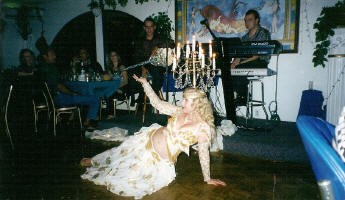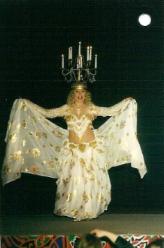Candles have
had a place in Middle Eastern rituals for hundreds of years. Like
many other aspects of oriental dance, the origins of Raks
Shamadan are not clear. Mahmoud Reda has stated that Turkish
court dancers of Egypt’s Ottoman rulers introduced the candelabra
dance to Egypt.
Originally the shamadan had no headband to support them, the
dancers of the past had to practice for years to perfect the
technique. While I was living in Egypt I had an opportunity to see a
tent show outside of Cairo that featured a dancer with this type of
shamadan.
The Zeffah al-arusah is the bridal procession, and in Egypt
the shamadan plays an important role. It is a tradition that
at least one shamadan crowned dancer leads the bridal party.
The Zeffah today often takes place in a hotel in the banquet
hall or at the military clubs in their private banquet room. I was
fortunate to perform for many of these wedding parties in hotels as
well as the officers clubs. I also received a medal from the
Egyptian Officer Club in 1993 to show their thanks and appreciation
for my art.
In former times it was an outdoor processional that accompanied the
bride to her new home. The shamadan bearing dancer lit the
way through the dark street in the days before electricity, and the
candle served as an announcement that a wedding had taken place.
Raks Shamadan made its way on to the Egyptian stage
eventually. As to who introduced it, there are several stories. One
alleges that the famous Lebanese nightclub owner, Badia Masbni,
invented the candelabra dance at her nightclub, Casino Badia, during
the I920s. Yet another story has it that Shafiyva ci Koptiyya
created Raks Shamadan, and that her student, Zouba el
Klobatyva, was the first to do the splits with a lit shamadan.
Nadia Hamdi is Egypt’s reigning queen of Raks Shamadan. She
is a 5th generation Mohammed Ali Street dancer. Her grandmother
learned Raks Shamadan from both Shafiyya el Koptiyya and
Zouba el Kobatyya. Nadia can inspire plenty of awe herself these
days; she glides to the floor in a graceful split, and then brings
her foot straight up—all while playing finger cymbals and wearing a
3-foot tall shamadan.
I purchased my shamadan from Ali Hamidzadeh of Turquoise
International. His exquisitely crafted shamadans are a more
refined version of those found in Egypt. They have lovely crystals
hanging and feature a structured headband to help hold them on your
head. Dancing with live fire despite the headband requires practice,
expertise and common sense. The shamadan with candles ablaze
is one of the most dramatic props in oriental dance. The drama comes
from the fact that the live flame is always potentially dangerous,
and balancing the shamadan is not easy. In Egypt I have seen
this dance performed with the full-length dress as well as the
normal belly dance costume.
|

Greek Village, Carlsbad CA
|

Hannover Germany Festival
|
A few safety tips to keep things under control are as follows:
One should check fire regulations for the place where the
performance will take place. Sometimes a fire marshal needs to be
present. While I was on a six city tour in Germany performing in
shows, one very nice theater in Munich refused to let me light my
candles. They had these battery-operated candles they let me use
instead. I had no chance to train with it before the show. The
batteries were so heavy on my neck and it was more difficult to
perform with it. Thank goodness I pulled it off but it was not a
comfortable feeling. Sometimes someone standing by with a fire
extinguisher is enough to allay any concern.
One must avoid collision with door frames and low-lying obstacles.
Be sure to bend your knees. I always ask how high are the ceilings
in homes if I do a private party with the shamadan.
One way to bypass the entire live flame/heavy battery issue is to
mount a leaf-shaped flame colored holographic palettes on toothpicks
and insert them in the candles. No chance of dripping hot wax on
your expensive costume and the effect is remarkably realistic.
Be sure to bend your knees to act as a shock absorber and it reduces
the risk of a hot wax shower and practice with lit candles. That way
there are no surprises.
Always scope out your performance area beforehand and avoid the air
conditioning ducts or fans. They can blow melted hot wax across your
head and extinguish your flame.
Bear in mind there is really no such thing as dripless candles when
they have been burning ten minutes or more, perched on a moving
object (your head). Make sure your drip cups are clean in order to
keep hot wax from spilling onto your head. Scrape out the drip cups
with a butter knife before or after each use.
To stabilize your candles, wrap the bottoms in aluminum foil strips
to thicken them. Then melt some hot wax into the bottoms of the drip
cups and push the candles in. This will hold it in place. Thicker
candles can just be screwed in tight to hold.
To stabilize your shamadan if it is too big, glue strips of
foam or felt in the inside of the headband or support bars as
padding. Foam door and window insulation strips work real well too.
You peel off the paper side, which is sticky and put it inside of
the headband and bars. It comes in different thicknesses so you can
get the right fit.
If your shamadan has crystal decorations it is a good idea to
keep jewelry pliers or tweezers with you as well as some wire for
the spot repairs. It is a good idea to have matches or lighter and
extra candies too.
This dance will brighten up any party or festive occasion and is
sure to make an impression, but practice, practice, practice before
ever attempting to perform the shamadan dance.
(Sakti C/O THE CARAVAN MAGAZINE: Vol. 17, 1)
Special thanks to Cymbal Magazine, Farhana, and Susan Grove Hess!
|